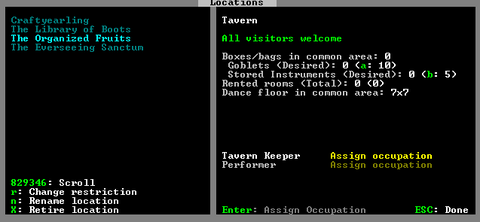- v50 information can now be added to pages in the main namespace. v0.47 information can still be found in the DF2014 namespace. See here for more details on the new versioning policy.
- Use this page to report any issues related to the migration.
Difference between revisions of "Locations"
m |
|||
| Line 8: | Line 8: | ||
A location is designated by setting up a [[meeting area]] and then going into the 'Assign location' submenu from the zone selection ({{key|i}}, hover over zone, {{key|l}}). This allows you to set the type of location you want. Once a location is set, the locations menu will contain information on that particular location, such as the restrictions and items contained. You can use this menu to restrict access from visitors or to retire the location. A location can have citizens with the appropriate occupation, which you set. You can also set the maximum number of items of a certain type. An occupation does not stop citizens from doing other jobs. | A location is designated by setting up a [[meeting area]] and then going into the 'Assign location' submenu from the zone selection ({{key|i}}, hover over zone, {{key|l}}). This allows you to set the type of location you want. Once a location is set, the locations menu will contain information on that particular location, such as the restrictions and items contained. You can use this menu to restrict access from visitors or to retire the location. A location can have citizens with the appropriate occupation, which you set. You can also set the maximum number of items of a certain type. An occupation does not stop citizens from doing other jobs. | ||
| − | Some [[room]]s can be assigned to locations to aid in the function of that location (for example, beds for taverns). Locations that require a dance floor will measure the amount of space available from a continuous uninterrupted rectangle. It will not consider free space between built furniture such as instruments, chairs, and tables, no matter how much there is. It's therefore optimal to build furniture in the tavern and temple such that they are all along the edges of the room or arranged in a sort of block. Designating a location exposed to outside tiles can be an effective way to prevent cave adaptation. It's not known if using the same area as a barracks would limit dance floor use. Doing this can be fun if there is evil rain or clouds around (bridges cannot be used because they would make a tile always inside, retracted or raised or not). Creating a location seems to be important to claim a site in adventure mode. | + | Some [[room]]s can be assigned to locations to aid in the function of that location (for example, beds for taverns). Locations that require a dance floor will measure the amount of space available from a continuous uninterrupted rectangle. It will not consider free space between built furniture such as instruments, chairs, and tables, no matter how much there is. It's therefore optimal to build furniture in the tavern and temple such that they are all along the edges of the room or arranged in a sort of block. Designating a location exposed to outside tiles can be an effective way to prevent [[cave adaptation]]. It's not known if using the same area as a barracks would limit dance floor use. Doing this can be fun if there is evil rain or clouds around (bridges cannot be used because they would make a tile always inside, retracted or raised or not). Creating a location seems to be important to be able to claim a site in adventure mode. |
{{Category|Fortress mode}} | {{Category|Fortress mode}} | ||
[[ru:Locations]] | [[ru:Locations]] | ||
Revision as of 11:42, 15 October 2019
v50.12 · v0.47.05 This article is about the current version of DF.Note that some content may still need to be updated. |
A location is either a library, tavern, or temple. They are viewed from the Locations and Occupations menu (l).
A location is designated by setting up a meeting area and then going into the 'Assign location' submenu from the zone selection (i, hover over zone, l). This allows you to set the type of location you want. Once a location is set, the locations menu will contain information on that particular location, such as the restrictions and items contained. You can use this menu to restrict access from visitors or to retire the location. A location can have citizens with the appropriate occupation, which you set. You can also set the maximum number of items of a certain type. An occupation does not stop citizens from doing other jobs.
Some rooms can be assigned to locations to aid in the function of that location (for example, beds for taverns). Locations that require a dance floor will measure the amount of space available from a continuous uninterrupted rectangle. It will not consider free space between built furniture such as instruments, chairs, and tables, no matter how much there is. It's therefore optimal to build furniture in the tavern and temple such that they are all along the edges of the room or arranged in a sort of block. Designating a location exposed to outside tiles can be an effective way to prevent cave adaptation. It's not known if using the same area as a barracks would limit dance floor use. Doing this can be fun if there is evil rain or clouds around (bridges cannot be used because they would make a tile always inside, retracted or raised or not). Creating a location seems to be important to be able to claim a site in adventure mode.

